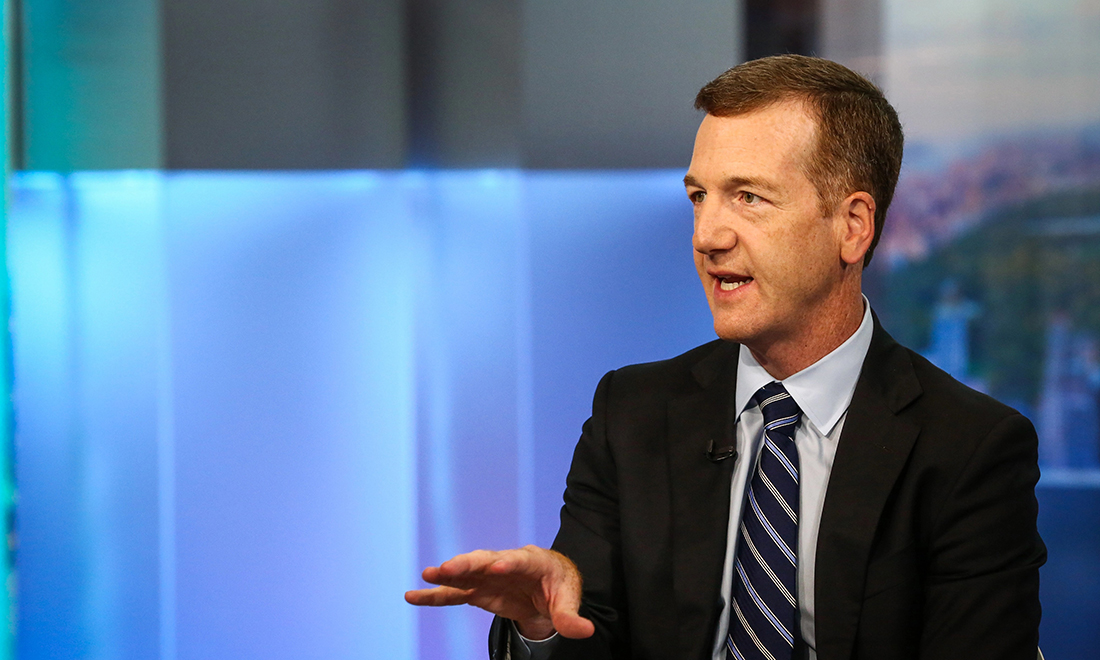
据华尔街最成功的策略师之一说,股市可能即将暴跌20%以上,但他在1月10日警告道,投资者还没有准备好应对未来的糟糕情况。
摩根士丹利(Morgan Stanley)的首席信息官、美国首席股票策略师迈克·威尔逊在美国消费者新闻与商业频道(CNBC)的《快钱》(Fast Money)节目上表示,标准普尔500指数(S&P 500)有可能下跌23%。这将导致该指数从目前的3,900点一路暴跌至3,000点。
虽然人们普遍认为经济衰退迫在眉睫,但在最新的《机构投资者》(Institutional Investor)调查中被评为首席股票策略师的威尔逊敦促交易员更重视潜在经济收缩带来的影响。
他说:“尽管大多数机构客户认为我们可能会陷入经济衰退,但他们似乎并不害怕这种情况的发生。这存在很大的脱节。”
这位摩根士丹利的首席信息官补充称,即将到来的财报季将给市场带来波动,因为许多企业的财务数据可能会低于预期。
“这是另一个让投资者有点自满的领域——成本的增长速度超过了净收入。” 威尔逊告诉美国消费者新闻与商业频道。“全年的预期必须下调。负经营杠杆确实开始从资产负债表流入损益表……这一事态发展在新冠疫情期间被严重低估。在疫情期间,由于正经营杠杆,我们获得了超额收益。”
他补充道:“当我们与人们交谈时,他们看空上半年的股市。但他们既没有做好准备应对惨淡的股市,也没有真正意识到情况会变得非常糟糕。”
俄乌冲突、持续高通胀、利率上升和经济不确定性扰乱了市场,到2022年年底,投资者遭受重创,美国股市遭遇了自大金融危机(Great Financial Crisis)以来最糟糕的一年。
尽管许多人希望,如果通胀增长持续放缓,美联储(Federal Reserve)就将开始逐步结束其激进的加息周期,但威尔逊在1月10日表示,他预计美联储目前还不会放缓加息步伐。
他解释说:“我们的预测主要基于盈利情况,以及美联储可能不会像历史上那样针对经济放缓采取相应措施。他们不会大幅降息导致经济增长放缓。”
股市会在2023年复苏吗?
在谈到美国股市时,威尔逊长期以来一直是华尔街最直言不讳的看空者之一。
2022年年底,他警告投资者要做好准备,标准普尔500指数将在2023年的前四个月达到3,000点至3,300点之间的水平,他一直坚持这样的观点。
在接受美国消费者新闻与商业频道采访之前,威尔逊曾经在一份研究报告中表示,企业盈利预期仍然过高,而股票风险溢价依然徘徊在2008年金融危机爆发以来的最低水平。他在研究报告中指出,这意味着标准普尔500指数可能跌至3,500点以下,这是市场预期经济会陷入衰退的反映——威尔逊预计,该指数将下跌22%,至3,000点左右。
标准普尔500指数目前的交易价格远高于威尔逊警告可能达到的水平,该指数在1月10日收于3,900点以上。
威尔逊对标准普尔500指数的年终价格目标是3,900点。
尽管威尔逊的预测是华尔街最看跌的预测之一,但许多其他大机构投资者都预计今年的市场将不太景气。
《财富》杂志在2022年年底汇总的一份公开预测显示,投资银行对2023年标准普尔指数的平均价格目标在4,000点左右。
标准普尔500指数从2022年的3,839.50点的收盘点位升至4,000点左右,这意味着年回报率开始出现积极反弹——根据纽约大学(New York University)的数据,2022年的年回报率下跌了18%,但这仍然将远低于标准普尔指数在2009年至2021年间16.4%的平均年回报率。
其他持谨慎态度的人包括Stifel公司的首席股票策略师巴里·班尼斯特,他在1月9日的一份研究报告中预测,标准普尔500指数到6月中旬可能会跳涨10%,达到4,300点,但他警告说,在这一止跌回升之后,未来十年将出现股市横盘。
2022年11月,高盛集团(Goldman Sachs)的策略师警告称,熊市尚未结束,预测标准普尔500指数在2023年年底时将收于4,000点,较1月10日的收盘价仅上涨2%。(财富中文网)
译者:中慧言-王芳
据华尔街最成功的策略师之一说,股市可能即将暴跌20%以上,但他在1月10日警告道,投资者还没有准备好应对未来的糟糕情况。
摩根士丹利(Morgan Stanley)的首席信息官、美国首席股票策略师迈克·威尔逊在美国消费者新闻与商业频道(CNBC)的《快钱》(Fast Money)节目上表示,标准普尔500指数(S&P 500)有可能下跌23%。这将导致该指数从目前的3,900点一路暴跌至3,000点。
虽然人们普遍认为经济衰退迫在眉睫,但在最新的《机构投资者》(Institutional Investor)调查中被评为首席股票策略师的威尔逊敦促交易员更重视潜在经济收缩带来的影响。
他说:“尽管大多数机构客户认为我们可能会陷入经济衰退,但他们似乎并不害怕这种情况的发生。这存在很大的脱节。”
这位摩根士丹利的首席信息官补充称,即将到来的财报季将给市场带来波动,因为许多企业的财务数据可能会低于预期。
“这是另一个让投资者有点自满的领域——成本的增长速度超过了净收入。” 威尔逊告诉美国消费者新闻与商业频道。“全年的预期必须下调。负经营杠杆确实开始从资产负债表流入损益表……这一事态发展在新冠疫情期间被严重低估。在疫情期间,由于正经营杠杆,我们获得了超额收益。”
他补充道:“当我们与人们交谈时,他们看空上半年的股市。但他们既没有做好准备应对惨淡的股市,也没有真正意识到情况会变得非常糟糕。”
俄乌冲突、持续高通胀、利率上升和经济不确定性扰乱了市场,到2022年年底,投资者遭受重创,美国股市遭遇了自大金融危机(Great Financial Crisis)以来最糟糕的一年。
尽管许多人希望,如果通胀增长持续放缓,美联储(Federal Reserve)就将开始逐步结束其激进的加息周期,但威尔逊在1月10日表示,他预计美联储目前还不会放缓加息步伐。
他解释说:“我们的预测主要基于盈利情况,以及美联储可能不会像历史上那样针对经济放缓采取相应措施。他们不会大幅降息导致经济增长放缓。”
股市会在2023年复苏吗?
在谈到美国股市时,威尔逊长期以来一直是华尔街最直言不讳的看空者之一。
2022年年底,他警告投资者要做好准备,标准普尔500指数将在2023年的前四个月达到3,000点至3,300点之间的水平,他一直坚持这样的观点。
在接受美国消费者新闻与商业频道采访之前,威尔逊曾经在一份研究报告中表示,企业盈利预期仍然过高,而股票风险溢价依然徘徊在2008年金融危机爆发以来的最低水平。他在研究报告中指出,这意味着标准普尔500指数可能跌至3,500点以下,这是市场预期经济会陷入衰退的反映——威尔逊预计,该指数将下跌22%,至3,000点左右。
标准普尔500指数目前的交易价格远高于威尔逊警告可能达到的水平,该指数在1月10日收于3,900点以上。
威尔逊对标准普尔500指数的年终价格目标是3,900点。
尽管威尔逊的预测是华尔街最看跌的预测之一,但许多其他大机构投资者都预计今年的市场将不太景气。
《财富》杂志在2022年年底汇总的一份公开预测显示,投资银行对2023年标准普尔指数的平均价格目标在4,000点左右。
标准普尔500指数从2022年的3,839.50点的收盘点位升至4,000点左右,这意味着年回报率开始出现积极反弹——根据纽约大学(New York University)的数据,2022年的年回报率下跌了18%,但这仍然将远低于标准普尔指数在2009年至2021年间16.4%的平均年回报率。
其他持谨慎态度的人包括Stifel公司的首席股票策略师巴里·班尼斯特,他在1月9日的一份研究报告中预测,标准普尔500指数到6月中旬可能会跳涨10%,达到4,300点,但他警告说,在这一止跌回升之后,未来十年将出现股市横盘。
2022年11月,高盛集团(Goldman Sachs)的策略师警告称,熊市尚未结束,预测标准普尔500指数在2023年年底时将收于4,000点,较1月10日的收盘价仅上涨2%。(财富中文网)
译者:中慧言-王芳
Stocks could be about to tumble more than 20%, according to one of the most successful strategists on Wall Street—but he warned on January 10 that investors aren’t prepared for how bad things could get.
Speaking on CNBC’s Fast Money show, Mike Wilson, CIO and chief U.S. equity strategist at Morgan Stanley, said the S&P 500 was susceptible to a drop of 23%. That would see the index nosedive from its current 3,900 points all the way down to 3,000.
While there is a broad consensus that a recession is looming, Wilson—who was ranked the No. 1 stock strategist in the latest Institutional Investor survey—urged traders to take the impact of a potential economic contraction more seriously.
“Even though a majority of institutional clients think we’re probably going to be in a recession, they don’t seem to be afraid of it,” he said. “That’s just a big disconnect.”
The Morgan Stanley CIO added that the coming earnings season would create volatility in the markets because many corporate financials were likely to come in below expectations.
“That’s another area investors are being a little bit complacent—costs are increasing faster than net revenues,” he told CNBC. “The full-year estimate has got to come down. Negative operating leverage is really starting to flow through to the income statement from the balance sheet… This is a very underappreciated development during COVID. We overearned during the pandemic because there was positive operating leverage.”
He added: “When we actually talk to people, they talk a bearish game about the first half. But they’re not really either positioned for it or they don’t really think that it’s going to be that bad.”
Investors were left bruised by the end of 2022, with U.S. stocks suffering their worst year since the Great Financial Crisis as markets were roiled by the war in Ukraine, persistently high inflation, interest rate rises, and economic uncertainty.
While many are hoping the Federal Reserve will begin to wind down its cycle of aggressive rate hikes if inflation growth continues to slow, Wilson said on January 10 that he wasn’t expecting the central bank to take its foot off the pedal just yet.
“Our call is predicated mostly on earnings and the fact that the Fed probably isn’t going to be as reactive to a slowdown as they have been historically,” he explained. “They’re not going to be slashing rates into a growth slowdown.”
Will the stock market recover in 2023?
Wilson has long been one of Wall Street’s most vocal bears when it comes to U.S. equities.
Toward the end of last year, he warned investors to brace for the S&P 500 to reach a level between 3,000 and 3,300 points within the first four months of 2023—and it’s a view he hasn’t shied away from.
His interview with CNBC came after he said in a research note that corporate earnings forecasts were still too high, while the equity risk premium was still hovering at its lowest since the lead-up to the 2008 financial crisis. This, he argued in the note, meant the S&P 500 could tumble far below the 3,500-point level being priced into markets in anticipation of a recession—Wilson predicted as much as a 22% fall to around 3,000 points.
The S&P is currently trading far higher than the levels Wilson warns could be reached, with the index closing at more than 3,900 points on January 10.
Wilson’s year-end price target for the S&P 500 is 3,900.
Although Wilson’s prediction is one of the most bearish on Wall Street, many of the other big players are expecting a less-than-bullish market this year.
A compilation of public forecasts put together by Fortune at the end of last year showed that investment banks’ average price target for the S&P in 2023 was around 4,000 points.
A rise from the S&P 500’s 2022 close of 3,839.50 to around 4,000 would imply a positive bounce from last year’s annual return—when it lost 18%, according to NYU—but it would still be far lower than the S&P’s average annual return of 16.4% between 2009 and 2021.
Others taking a wary stance include Barry Bannister, chief equity strategist at Stifel, who predicted in a research note on January 9 that the S&P 500 could jump 10% higher by mid-June to reach 4,300 points—but warned that the rally would precede a decade of flat stock markets.
In November 2022, strategists at Goldman Sachs warned that the bear market wasn’t over yet, predicting the S&P 500 would end 2023 at 4,000 points—an increase of just 2% from January 10’s close.






